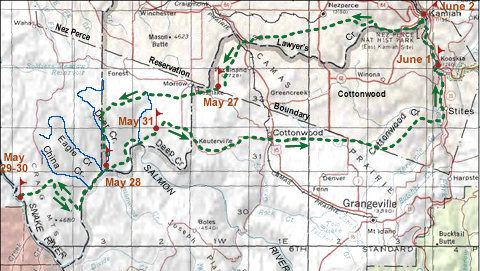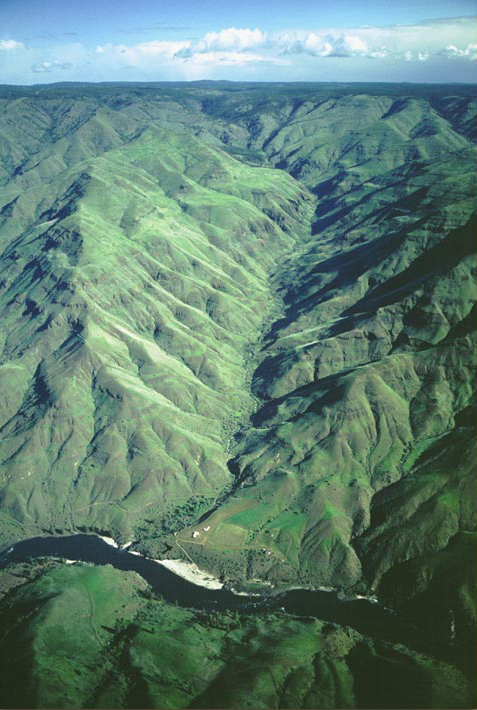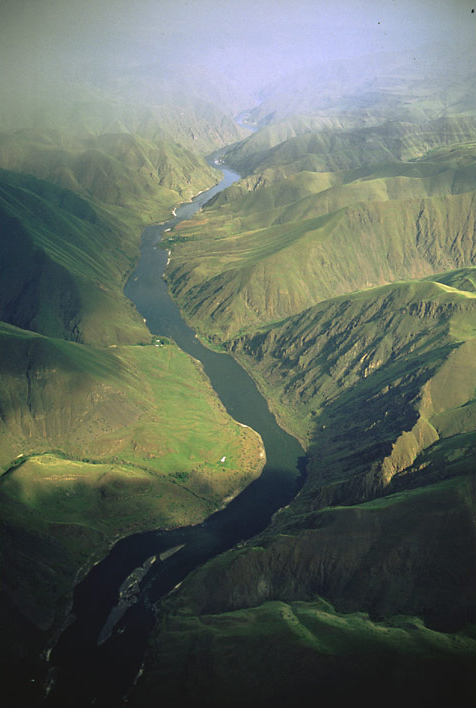It is regrettable that Sgt. Ordway neglected to record the courses and distances they traveled, for his descriptions have challenged a number of students and scholars to make sense out of them on the ground. The map shown above represents a rough summary of the conclusions of Steve F. Russell, of Iowa State University, who also provided the coordinates that aerial photographer Jim Wark used to shoot the pictures featured on this page.
No Mere Half Day’s Ride
The rickety bridge of language between the two cultures had collapsed somewhere between the Sahaptian tongue of the Nez Perces and the English ears of the captains, but evidently nobody realized it for several days. At seven a.m. on that cloudy Tuesday morning, 27 May 1806, Sergeant John Ordway, accompanied by Privates Robert Frazer and Peter Weiser, left Long Camp under orders to ride over to “the East branch of Lewis’s river”—the Salmon River, or Tommanamah, as the Nez Perce called it. The spring run of chinooks had not yet appeared on the Clearwater River, so the three were to buy some fresh fish, “which the indians inform us may be procured in abundance at that place.” As the captains understood it, the trip would be “but half a days ride, nearly south.”
We haven’t a single clue as to where or when the error had occurred, or whose face was red. Neither captain expressed any concerns until six days had passed, when Lewis mused, “we begin to feel some anxiety with rispect to Sergt Ordway and party; . . . we have received no inteligence of them since they set out.” But of course Lewis had been immersed in his natural history studies, examining one specimen after another, and writing a description of each. Lewis’s woodpecker, Clark’s nutcracker, squirrel, hoot-owl, horned lizard. Chokecherry, elkhorn, various grasses. Insects such as the yellowjacket. Puzzling over the local distinctions between white bear and black bear. All of the party were growing impatient to head home. By the last day of May they owned a remuda of 65 horses. Maybe they were too busy to worry about the three tardy men. Or, more likely, they had enough confidence in them to assume they would return safely in due time.
Ordway’s 27 May Camp
Nezperce, Idaho, view southwest
© 2003 Airphoto, Jim Wark. All rights reserved. Waypoints suggested by Steve L. Russell.
The settlement in the foreground, called Nezperce, is a farmer’s market on the high Camas Prairie. The prominent point on the southwest horizon is Cottonwood Butte. On 27 May 1806, Ordway, Frazer, and Weiser rode through this area toward the upper left of the photo and spent the night at an Indian village. When a thunderstorm struck, the Nez Perce evidently offered them shelter in their lodges. Ordway complained, “the Indians grass houses leak.”
Indeed they did. At noon on 2 June the three rode back into camp, bringing 17 salmon and some cous (“cows”) roots. Unfortunately, most of the fish had already crossed the line into garbage class, although Lewis, always inclined to accentuate the positive, allowed that:
these fish were as fat as any I ever saw; sufficiently so to cook themselves without the addition of grease; those which were sound were extreemly delicious; their flesh is of a fine rose colour with a small admixture of yellow.
By the very shortest route, the Salmon River was about 35 miles southwest of Long Camp, which would have made it at least a two-day trip. Lewis was inclined to blame the Indians for the extension. The three Americans:
did not reach the place at which they obtained their fish untill the evening of the 29th having travelled by their estimate near 70 miles. the route they had taken however was not a direct one; the Indians conducted them in the first instance to the East branch of Lewis’s river [the Salmon] about 20 miles above it’s junction with the South branch [the Snake River], a distance of about 50 Ms. where they informed them they might obtain fish; but on their arrival at that place finding that the salmon had not yet arrived or were not taken, they were conducted down that river to a fishery a few miles below the junction of the forks of Lewis’s river about 20 Ms. further, here with some difficulty and remaining one day they purchased the salmon which they brought with them.
From the Salmon to the Snake
Deer Creek: “A bad hill”
© 2003 Airphoto, Jim Wark. All rights reserved. Waypoints recommended by Steve L. Russell.
Ordway had little to say about the day’s events on 28 May 1806, except that “towards evening we descended a bad hill down on a creek, followed it down Some distance and arived at a village where we camped.” It is believed that they followed a route down the ridge at left of Deer Creek, and that the village was somewhere above the Salmon River (bottom of photo). Apparently the salmon had not yet arrived in this part of the river.
After an all-night rain, Ordway and his two companions proceeded on, in the rain, at an early hour on the twenty-ninth.
Shortly arived at a fork of the kimooenim or Lewis’s river . . . crossed a steep bad hill and descended down a long hill an a run pass a large lodge and descended the worse hills we ever saw a road made down. towards evening we arived at the kimooenim or Lewises river at a fishery at a bad rapid.
In fact, Ordway told Lewis, it was “a very considerable rapid nearly as great . . . as the [rapids] of the Columbia,” which had been major challenges to surmount, both going and coming. Ordway’s journal continues:
our chief told us to set down and not go in the lodge untill we were invited so we did at length they invited us in. spread robes for us to sit on and Set a roasted Salmon before us and Some of their white bread which they call uppah.
“Uppah” was a cake or bread made of the root of cous (Lomatium cous; lo-may-she-um cowz).
A Razor for Spanish Dollars
Early that morning Bob Frazer “got 2 Spanish mill dollars from a squaw in return for an old razer,” Ordway tells us. It would be interesting to know just how the conversation got started, and who said what, but that must remain one of history’s little secrets. Nevertheless, we can entertain some reasonable guesses about the feelings of the two principals.
The woman, most likely, felt it was a good bargain, insofar as she had gotten the better half of the deal. She probably had never seen or heard of a razor before. And even if Frazer’s attempt to describe its normal use in her Sahaptian language—with the aid of some supplementary gesticulations, of course—were clear, she may have been either puzzled or amused. Could she imagine any man letting hair grow under his nose and mouth, and then hacking it off with this thing? Why wouldn’t he just yank it out one hair at a time like Nim”ipuu men did?[1]Meriwether Lewis, 13 May 1806: “In common with other savage nations of America they extract their beards but the men do not uniformly extract the hair below, this is more particularly confined … Continue reading What really excited her, one supposes, was the contemplation of the ways this strange, shiny instrument might make some of her daily tasks easier. Scraping stems of dogbane, for instance, to make thread and string, preparing animal hides for clothing and moccasins, peeling roots.[2]James P. Ronda, “Frazer’s Razor, The Ethnohistory of a Common Object,” We Proceeded On, Vol. 7 (August 1981), 12-13.
The fact that Robert had a razor with him is a reminder that Army regulations at the time required soldiers to be clean-shaven. That he was prepared to part with it suggests either that the blade was no longer useable for shaving, or else the captains had approved a general exception to the Army’s rule. Or both. But why would he trade it for those two foreign coins when there was no place for him to spend them and when, besides, his mission was to buy food for the men back at Long Camp? Possibly because the razor was his personal property to dispose of, and he recognized the Spanish coins as a windfall that would increase in value precipitously the moment the expedition was over. Those two dollars would equal almost half a month’s pay for a lowly private.[3]See Soldier Pay.
A Piece of Eight
In 1776, when the Continental Congress began studying the comparative values of the various gold and silver coins being used in the Colonies, its measuring stick was the Spanish milled dollar, the oldest and most stable of all. (In Spanish currency it was equal to eight coins called reales, and therefore was dubbed “a piece of eight.”) At that time, the value of any coin was determined not by its face value but by its weight, and thus by its gold or silver content. The problem with most other coins at the time was that thieves often scraped or clipped the typically smooth edges and cast counterfeit coins from accumulated shavings. Little by little the intrinsic value of each coin in circulation was reduced. In general, no two were exactly the same size and value. The Spanish dollar, on the other hand, which had been minted in Mexico and Peru for nearly three hundred years, had a milled edge with a pattern that simulated braided rope. That pattern discouraged counterfeiters since any shaving was immediately apparent and obviously devalued the coin. When the U.S. Mint was established in Philadelphia in 1792, its purpose was to issue dollars that would meet the Spanish standard, pursuant to the doctrine espoused by Alexander Hamilton and Thomas Jefferson, and their adherents. Indeed, the Spanish milled dollar remained in circulation throughout the United States until the 1850s.[4]Edwin Kemmerer, Gold and the Gold Standard: The Story of Gold Money, Past, Present and Future (New York: McGraw-Hill, 1944), 53-71.
Back to Long Camp
Ordway added a pertinent remark to his journal entry: “[W]e expect they got them from the Snake Indians who live near the Spanish country to the South.” More of the story unfolded after he, Weiser and Frazer got back to main camp on 2 June. Sgt. Gass heard that the Nez Perce had:
got the dollars from about a Snake Indian’s neck, they had killed some time ago. There are several dollars among these people which they get in some way. We suppose the Snake Indians, some of whom do not live very far from New Mexico, got them from the Spaniards in that quarter.
Sgt. Ordway, 1 June 1806:
night came on and we Camped here at the chiefs lodge that gave us so many horses they appeared verry friendly to us and gave us a large cake of uppah their is a vast site of excellent horses Scattered along this river which they offer to Sell for a Squaw axe or peace & 2 or 3 for a gun & a little ammunt [ammunition].”
The next morning they “Set out eairly and turned down the river,” and arrived at Long Camp at about noon. The chief was Hohots Ilppilp, or “red grizzly.” His village was near the mouth of the South Fork, somewhere below the center of this photo. According to Nez Perce lore, his sister bore a son of Captain Clark who was with the Non-Treaty Nez Perce bands at the Battle of the Bear Paw Mountains in 1877, was deported with the survivors to Oklahoma, and died there.
Notes
| ↑1 | Meriwether Lewis, 13 May 1806: “In common with other savage nations of America they extract their beards but the men do not uniformly extract the hair below, this is more particularly confined to the females. I observed several men among them whom I am convinced if they had shaved their beards instead of extracting it would have been as well supplyed in this particular as any of my countrymen.” |
|---|---|
| ↑2 | James P. Ronda, “Frazer’s Razor, The Ethnohistory of a Common Object,” We Proceeded On, Vol. 7 (August 1981), 12-13. |
| ↑3 | See Soldier Pay. |
| ↑4 | Edwin Kemmerer, Gold and the Gold Standard: The Story of Gold Money, Past, Present and Future (New York: McGraw-Hill, 1944), 53-71. |
Experience the Lewis and Clark Trail
The Lewis and Clark Trail Experience—our sister site at lewisandclark.travel—connects the world to people and places on the Lewis and Clark Trail.
Discover More
- The Lewis and Clark Expedition: Day by Day by Gary E. Moulton (University of Nebraska Press, 2018). The story in prose, 14 May 1804–23 September 1806.
- The Lewis and Clark Journals: An American Epic of Discovery (abridged) by Gary E. Moulton (University of Nebraska Press, 2003). Selected journal excerpts, 14 May 1804–23 September 1806.
- The Lewis and Clark Journals. by Gary E. Moulton (University of Nebraska Press, 1983–2001). The complete story in 13 volumes.






